-
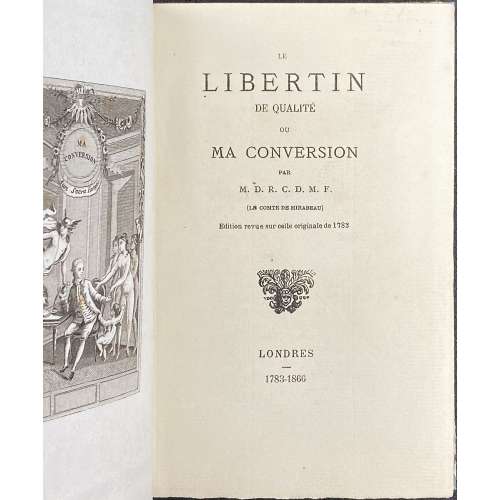 Hardcover volume, 17 x 11.3 cm, in-12, quarter orange cloth (percaline) over marbled boards, black morocco label with gilt lettering to spine, marbled endpapers, text printed on laid paper, five plates on India paper (papier Chine). Title-page: LE | LIBERTIN | DE QUALITÉ | OU | MA CONVERSION | PAR | M. D. R. C. D. M. F. | (LE COMTE DE MIRABEAU) | Edition revue sur celle originale de 1783 | {fleuron} | LONDRES | – | 1783-1866 || Pagination: [4] (h.t., t.p.), [1] 2-200; total 204 pages plus 5 engraved plates, incl. frontispiece; 2 blank leaves at the front and 2 at the back, laid paper, watermarked Canson & Montgolfier. Catalogue raisonné: Dutel I: A-653. Ref.: Illustrations were earlier published in Vie privée, libertine et scandaleuse de feu Honoré-Gabriel Riquetti Comte de Mirabeau, 1791, (see [LIB-2633.2021] Apollinaire, et al. L’Enfer de la Bibliothèque nationale, 1912 : № 795). M. D. R. C. D. M. F stands for Monsieur de Riqueti comte de Mirabeau Fis. Catalogue Poulet-Malassis & ses amis description: № 55. M. D. R. C. D. M. F. (le comte de Mirabeau). Le Libertin de qualité ou Ma conversion, édition revue sur celle de l’originale de 1783. Londres 1783-1866 [Christiaens, 1867]. In-12 de 2 .n.ch. et 200 pages, demi-percaline orange, pièce de titre, tête jaspée, tranches naturelles (reliure de l’époque). Illustré de 5 gravures originales, dont l’une en frontispice, qui reprennent celles de l’édition de Vie privée libertine et scandaleuse de feu Honoré-Gabriel-Riqueti, ci-devant comte de Mirabeau [...] de 1791. Contributors: Honoré-Gabriel Riqueti de Mirabeau (French, 1749 – 1791) – author. Alexis Christiaens (Belgian, d. 1880) – publisher.
Hardcover volume, 17 x 11.3 cm, in-12, quarter orange cloth (percaline) over marbled boards, black morocco label with gilt lettering to spine, marbled endpapers, text printed on laid paper, five plates on India paper (papier Chine). Title-page: LE | LIBERTIN | DE QUALITÉ | OU | MA CONVERSION | PAR | M. D. R. C. D. M. F. | (LE COMTE DE MIRABEAU) | Edition revue sur celle originale de 1783 | {fleuron} | LONDRES | – | 1783-1866 || Pagination: [4] (h.t., t.p.), [1] 2-200; total 204 pages plus 5 engraved plates, incl. frontispiece; 2 blank leaves at the front and 2 at the back, laid paper, watermarked Canson & Montgolfier. Catalogue raisonné: Dutel I: A-653. Ref.: Illustrations were earlier published in Vie privée, libertine et scandaleuse de feu Honoré-Gabriel Riquetti Comte de Mirabeau, 1791, (see [LIB-2633.2021] Apollinaire, et al. L’Enfer de la Bibliothèque nationale, 1912 : № 795). M. D. R. C. D. M. F stands for Monsieur de Riqueti comte de Mirabeau Fis. Catalogue Poulet-Malassis & ses amis description: № 55. M. D. R. C. D. M. F. (le comte de Mirabeau). Le Libertin de qualité ou Ma conversion, édition revue sur celle de l’originale de 1783. Londres 1783-1866 [Christiaens, 1867]. In-12 de 2 .n.ch. et 200 pages, demi-percaline orange, pièce de titre, tête jaspée, tranches naturelles (reliure de l’époque). Illustré de 5 gravures originales, dont l’une en frontispice, qui reprennent celles de l’édition de Vie privée libertine et scandaleuse de feu Honoré-Gabriel-Riqueti, ci-devant comte de Mirabeau [...] de 1791. Contributors: Honoré-Gabriel Riqueti de Mirabeau (French, 1749 – 1791) – author. Alexis Christiaens (Belgian, d. 1880) – publisher. -
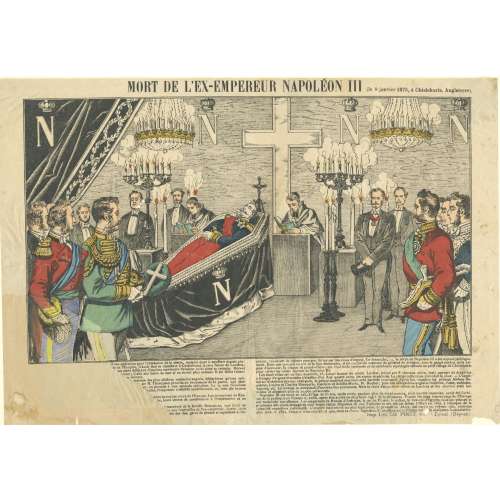 Hand-coloured woodcut on wove paper, 270 x 380 mm; attached to the sheet 303 x 442 mm with pencil ms inscription to the top left corner on the reverse: “Haye le 2-3-75”. Top: "MORT DE L'EX-EMPEREUR NAPOLÉON III (le 9 janvier 1873, à Chislehurts [sic], Angleterre)." Bottom right: "Imp. Lith. CH. PINOT, éditeur. Épinal (Dépose)". Bottom left corner of the image sheet torn and manually restored. Text partially lost, starting with « d’une opération pour l’extraction de la pierre, maladie dont’ il souffrait depuis plu-… ». See Chislehurst. Charles-François Pinot (French, 1817 – 1879) – publisher/printer.
Hand-coloured woodcut on wove paper, 270 x 380 mm; attached to the sheet 303 x 442 mm with pencil ms inscription to the top left corner on the reverse: “Haye le 2-3-75”. Top: "MORT DE L'EX-EMPEREUR NAPOLÉON III (le 9 janvier 1873, à Chislehurts [sic], Angleterre)." Bottom right: "Imp. Lith. CH. PINOT, éditeur. Épinal (Dépose)". Bottom left corner of the image sheet torn and manually restored. Text partially lost, starting with « d’une opération pour l’extraction de la pierre, maladie dont’ il souffrait depuis plu-… ». See Chislehurst. Charles-François Pinot (French, 1817 – 1879) – publisher/printer. -
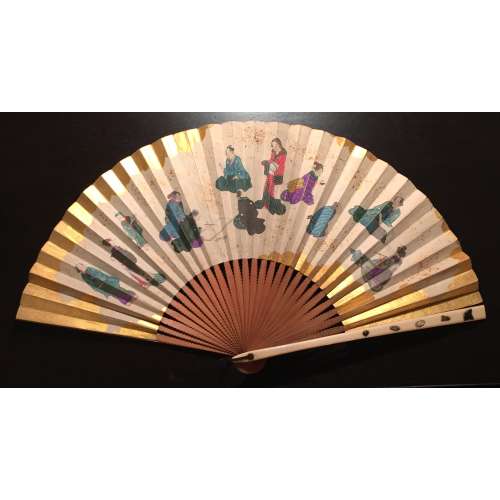 Late 19th-century (1850-1870) Japanese export fan. This fan has a double leaf painted with a different design on either side. Ivory encrusted with gemstones and other materials. Subject matter such as women wearing kimono is also more typical of export than domestic products (V&A). Autumn theme on the reverse.
Late 19th-century (1850-1870) Japanese export fan. This fan has a double leaf painted with a different design on either side. Ivory encrusted with gemstones and other materials. Subject matter such as women wearing kimono is also more typical of export than domestic products (V&A). Autumn theme on the reverse. -
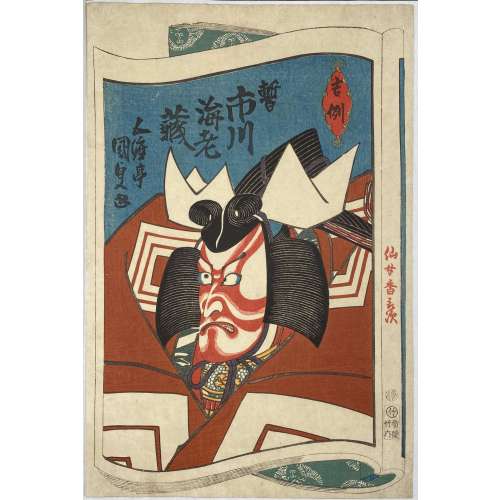 Ichikawa Ebizo V (1791 – 1859) a.k.a. Ichikawa Danjûrô VII was a great-great-great-son of Ichikawa Danjûrô I. He started his stage career in 1794, at the age of 4, playing in Shibaraku (the role he is depicted here). During his stage life, he played every role type. He was later banished from Edo for living too luxurious life for an actor. While in exile he flourished in Kioto and Osaka. Kichirei (Festive Annual Custom). Publisher: Takenouchi Magohachi (Hoeidô) Circa 1833. Description: 役者の舞台姿を描いた「舞台姿」シリーズと、日常図を描いた「千社詣」シリーズがあり、同じ役者が向かい合って対になる。(『五渡亭国貞』). Signed: Gototei Kunisada ga [五渡亭国貞画]. Censor's seal: kiwame 改印:極. Ref.: Shindo, Gototei Kunisada Yakusha-e no Sekai (1993), plate 88; Utagawa Kunisada, 150th Anniversary of His Death, Ota Memorial Museum, no. 169; MFA ACCESSION NUMBER 11.43128.
Ichikawa Ebizo V (1791 – 1859) a.k.a. Ichikawa Danjûrô VII was a great-great-great-son of Ichikawa Danjûrô I. He started his stage career in 1794, at the age of 4, playing in Shibaraku (the role he is depicted here). During his stage life, he played every role type. He was later banished from Edo for living too luxurious life for an actor. While in exile he flourished in Kioto and Osaka. Kichirei (Festive Annual Custom). Publisher: Takenouchi Magohachi (Hoeidô) Circa 1833. Description: 役者の舞台姿を描いた「舞台姿」シリーズと、日常図を描いた「千社詣」シリーズがあり、同じ役者が向かい合って対になる。(『五渡亭国貞』). Signed: Gototei Kunisada ga [五渡亭国貞画]. Censor's seal: kiwame 改印:極. Ref.: Shindo, Gototei Kunisada Yakusha-e no Sekai (1993), plate 88; Utagawa Kunisada, 150th Anniversary of His Death, Ota Memorial Museum, no. 169; MFA ACCESSION NUMBER 11.43128. -
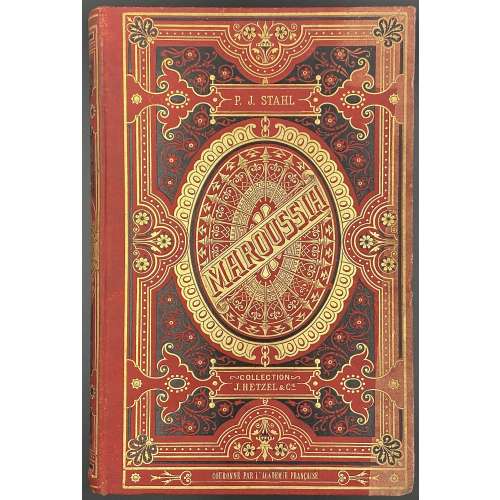 Title: MAROUSSIA | PAR | P.-J. STAHL | D'APRÈS UNE LÉGENDE DE MARKOWOVZOK | DESSINS PAR TH. SCHULER | GRAVURES PAR PANNEMAKER | {vignette} | BIBLIOTHÈQUE | D'ÉDUCATION ET DE RÉCRÉATION | J. HETZEL ET Cie, 18, RUE JACOB | PARIS | Tous droits de reproduction et de traduction réservés || Pagination: [2] – t.p. / blank, [1, 2] – dedication / blank, [3] 4-272, [1] 2-11 [12] – publisher’s advert.; Frontispiece and 22 leaves of wood-engraved plates by F. Pannemaker after Th. Schuler, extraneous to collation, woodcut head- and tailpieces, vignettes in the text by Charles Baude. Collation: 4to; 1-344, + 6 leaves of publisher's advertisement. Binding: “Cartonnage Hetzel” – red cloth stamped in gilt and black with the elements of design to spine, front and back, publisher's device to back, AEG. Author and publisher: Pierre-Jules Hetzel [P.-J. Stahl] (French, 1814 – 1886). Artist: Jules Théophile Schuler (French, 1821 – 1878). Engravers: Adolphe François Pannemaker (Belgian-French, 1822 – 1900) and Charles Baude (French, 1853 – 1935). Author of the legend: Markowovzok [Marko Vovchok; Марко́ Вовчо́к, real name Mariya Vilinskаya; Мария Александровна Вилинская] (Ukrainian, 1833 – 1907). Series: Collection Hetzel (stamped on the front board). Typographie A. Lahure (Paris), Alexis Lahure (French, 1849 – 1929). MAROUSSIA – The French version of the Ukrainian name Маруся.
Title: MAROUSSIA | PAR | P.-J. STAHL | D'APRÈS UNE LÉGENDE DE MARKOWOVZOK | DESSINS PAR TH. SCHULER | GRAVURES PAR PANNEMAKER | {vignette} | BIBLIOTHÈQUE | D'ÉDUCATION ET DE RÉCRÉATION | J. HETZEL ET Cie, 18, RUE JACOB | PARIS | Tous droits de reproduction et de traduction réservés || Pagination: [2] – t.p. / blank, [1, 2] – dedication / blank, [3] 4-272, [1] 2-11 [12] – publisher’s advert.; Frontispiece and 22 leaves of wood-engraved plates by F. Pannemaker after Th. Schuler, extraneous to collation, woodcut head- and tailpieces, vignettes in the text by Charles Baude. Collation: 4to; 1-344, + 6 leaves of publisher's advertisement. Binding: “Cartonnage Hetzel” – red cloth stamped in gilt and black with the elements of design to spine, front and back, publisher's device to back, AEG. Author and publisher: Pierre-Jules Hetzel [P.-J. Stahl] (French, 1814 – 1886). Artist: Jules Théophile Schuler (French, 1821 – 1878). Engravers: Adolphe François Pannemaker (Belgian-French, 1822 – 1900) and Charles Baude (French, 1853 – 1935). Author of the legend: Markowovzok [Marko Vovchok; Марко́ Вовчо́к, real name Mariya Vilinskаya; Мария Александровна Вилинская] (Ukrainian, 1833 – 1907). Series: Collection Hetzel (stamped on the front board). Typographie A. Lahure (Paris), Alexis Lahure (French, 1849 – 1929). MAROUSSIA – The French version of the Ukrainian name Маруся. -
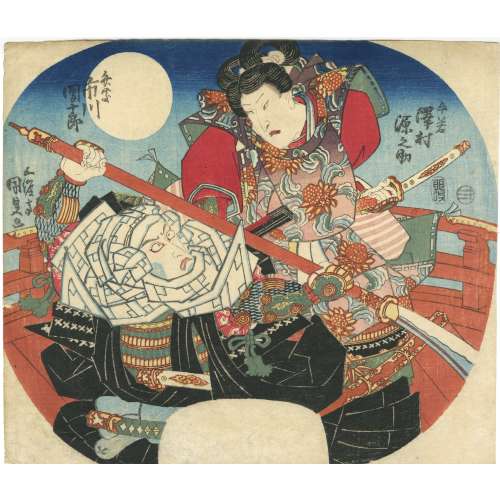 Sawamura Gennosuke II [沢村源之助] (Suketakaya Takasuke III, Sawamura Chōjūrō V, Sawamura Sōjūrō V, Sawamura Tosshō I, Sawamura Genpei I, Japanese, 1802/7 – 1853) as Ushiwakamaru [牛若丸], a.k.a. Minamoto no Yoshitsune [源 義経]. Ichikawa Danjūrō VII [市川団十郎] (Ichikawa Ebizō V, Ichikawa Hakuen II, Ichikawa Shinnosuke I, Japanese, 1791 – 1859) as Benkei, a.k.a. Saitō Musashibō Benkei [西塔武蔵坊弁慶] (Japanese, 1155 – 1189) Performance: Grand finale dance play [大切所作事] (ōgiri shosagoto) at Soga Festival - A Composite Piece of Musashi「曽我祭武蔵摂物 ごさいれいむさしのひきもの)」 (Gosairei Musashi no hikimono), performed at Kawarazakiza (河原崎座) in 05/1831 (See kabuki plays from 1831). Soga Festival (Soga Matsuri) is an annual theatre event in Edo (Tokyo). Scene: The Fight on Gojo Bridge or Benkei on the Bridge [橋弁慶] (Hashi Benkei). The story relates how Benkei, first a monk, then a mountain ascetic, and then a rogue warrior, a man of Herculean strength, was subdued by the young Onzoshi Ushiwaka Maru (Yoshitsune) on Gojo Bridge. Benkei wandered around Kyoto with the intention of relieving 1000 samurai of their swords. One night, with one more sword to go, he saw Yoshitsune playing the flute and wearing a golden sword at the Gojotenjin Shrine. They agreed to fight on Gojo Bridge in southern Kyoto. However, Yoshitsune was too agile for Benkei and had been educated in the secrets of fighting by the tengu. Following Yoshitsune’s victory, Benkei became Yoshitsune’s retainer. Artist: Utagawa Kunisada [歌川 国貞], a.k.a. Toyokuni III (Japanese, 1786 – 1865). Publisher: Ibaya Senzaburo [伊場屋仙三郎]. Signed: Gototei Kunisada ga [五渡亭国貞画]. Date-aratame seal: Tenpō 2 (1831). Size: Fan print (uchiwa-e). Ref.: (1) Tokyo Metropolitan Library, 請求記号 M339-6/東M339-006. (2) Ritsumeikan University, Art Research Center, Portal Database M339-006(02).
Sawamura Gennosuke II [沢村源之助] (Suketakaya Takasuke III, Sawamura Chōjūrō V, Sawamura Sōjūrō V, Sawamura Tosshō I, Sawamura Genpei I, Japanese, 1802/7 – 1853) as Ushiwakamaru [牛若丸], a.k.a. Minamoto no Yoshitsune [源 義経]. Ichikawa Danjūrō VII [市川団十郎] (Ichikawa Ebizō V, Ichikawa Hakuen II, Ichikawa Shinnosuke I, Japanese, 1791 – 1859) as Benkei, a.k.a. Saitō Musashibō Benkei [西塔武蔵坊弁慶] (Japanese, 1155 – 1189) Performance: Grand finale dance play [大切所作事] (ōgiri shosagoto) at Soga Festival - A Composite Piece of Musashi「曽我祭武蔵摂物 ごさいれいむさしのひきもの)」 (Gosairei Musashi no hikimono), performed at Kawarazakiza (河原崎座) in 05/1831 (See kabuki plays from 1831). Soga Festival (Soga Matsuri) is an annual theatre event in Edo (Tokyo). Scene: The Fight on Gojo Bridge or Benkei on the Bridge [橋弁慶] (Hashi Benkei). The story relates how Benkei, first a monk, then a mountain ascetic, and then a rogue warrior, a man of Herculean strength, was subdued by the young Onzoshi Ushiwaka Maru (Yoshitsune) on Gojo Bridge. Benkei wandered around Kyoto with the intention of relieving 1000 samurai of their swords. One night, with one more sword to go, he saw Yoshitsune playing the flute and wearing a golden sword at the Gojotenjin Shrine. They agreed to fight on Gojo Bridge in southern Kyoto. However, Yoshitsune was too agile for Benkei and had been educated in the secrets of fighting by the tengu. Following Yoshitsune’s victory, Benkei became Yoshitsune’s retainer. Artist: Utagawa Kunisada [歌川 国貞], a.k.a. Toyokuni III (Japanese, 1786 – 1865). Publisher: Ibaya Senzaburo [伊場屋仙三郎]. Signed: Gototei Kunisada ga [五渡亭国貞画]. Date-aratame seal: Tenpō 2 (1831). Size: Fan print (uchiwa-e). Ref.: (1) Tokyo Metropolitan Library, 請求記号 M339-6/東M339-006. (2) Ritsumeikan University, Art Research Center, Portal Database M339-006(02).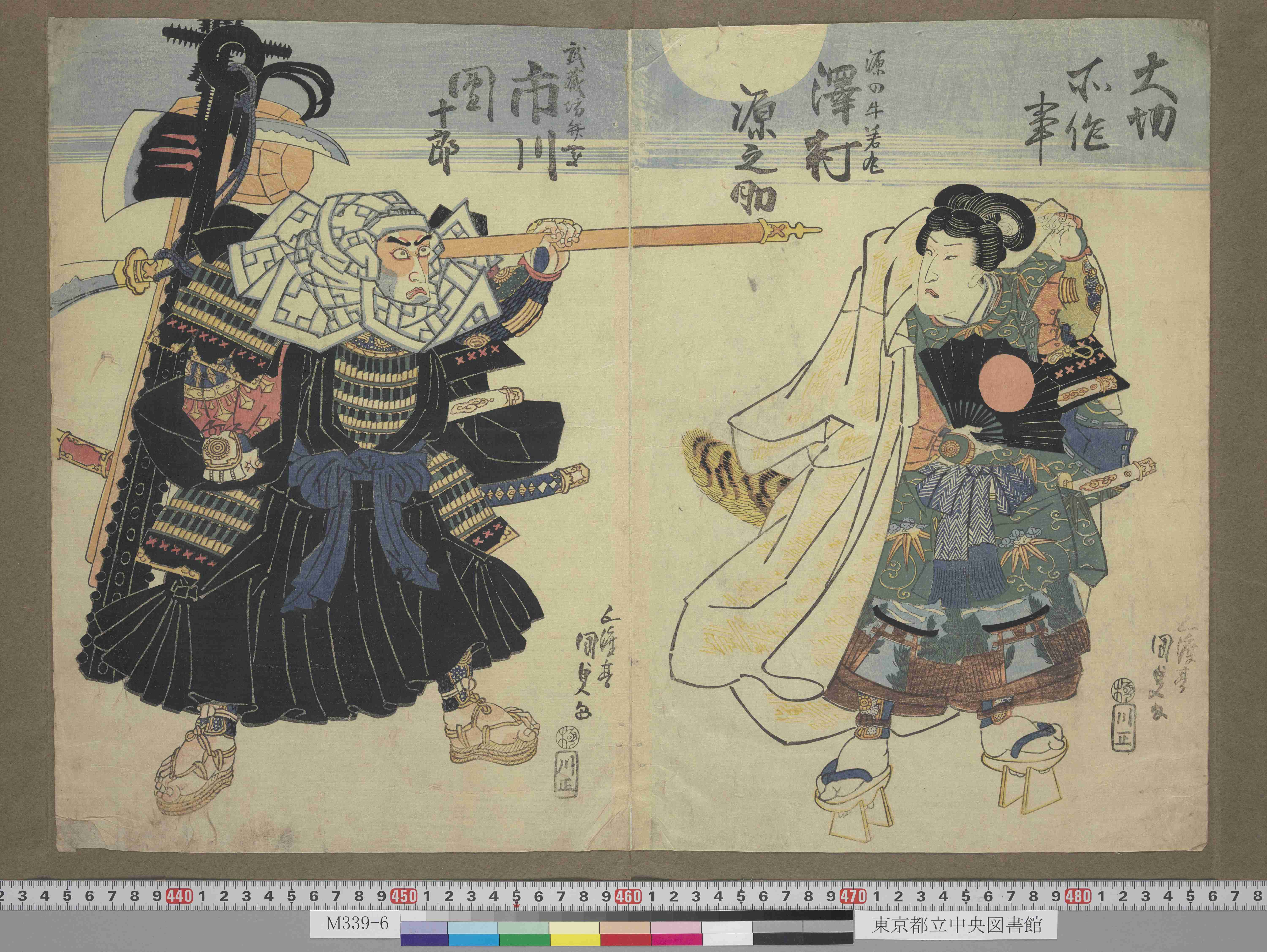
-
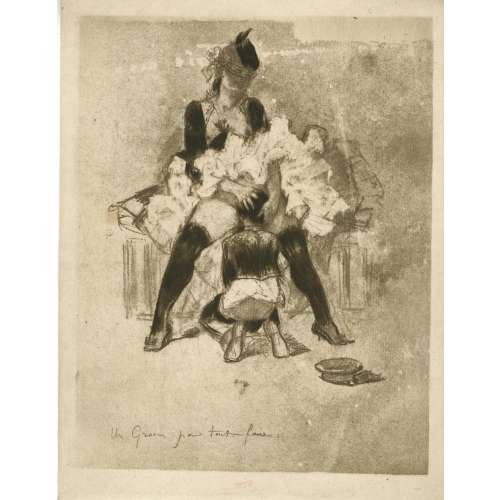
Etching on laid paper, depicting a kneeling groom with his head between the spread legs of a bare-breasted woman in a veiled hat. Inscribed on plate: Un groom a tout faire. Owner's stamp LVM on verso.
Dimensions: Paper: 24.4 x 15.8 cm; Image: 12 x 7.5 cm
Catalogue raisonné: Arthur Hubschmid (1977): 662.
-
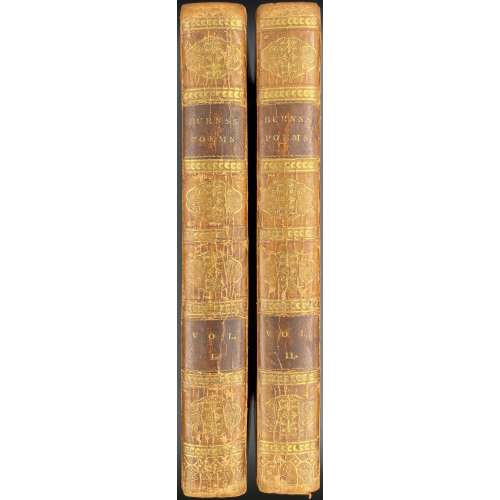 Description: Two volumes, collated 4to, usually described as 12mo, 16.5 x 10.5 cm each, uniformly bound in full calf, bordered in gilt with a triple-fillet over blind dentelle, flat spine ornamented in gilt with two crimson labels, gilt dentelle inside, blue marbled endpapers with previous owner bookplate to front pastedown in each vol.: "W. E. A. MACDONNELL. | NEW HALL | Co. of Clare.", and a ticket in a blue border “162”. Illustrated by T. Bewick after J. Thurston with frontispiece portrait of Robert Burns, numerous woodcut endpieces and a total of 14 full-page woodcut vignettes throughout. Title-page: THE | POETICAL WORKS | OF | ROBERT BURNS; | WITH HIS LIFE | ORNAMENTED WITH | ENGRAVINGS ON WOOD BY MR. BEWICK | FROM ORIGINAL DESIGNS BY MR. THURSTON. | — | IN TWO VOLUMES. | VOL I. (VOL. II.) | — | ALNWICK: | Printed by William Davison. | SOLD BY THE BOOKSELLERS IN ENGLAND, SCOTLAND | AND IRELAND. | – | 1808. || Vol. 1: Collation: π3 (1st blank, engraved frontispiece portrait of R. Burns, t.p.), a2 b-e4, A-Z4, 2A-2E4 (2E)4 (last two blank); total 137 leaves, numerous endpieces and 9 woodcut plates by Thomas Bewick after John Thurston within collation. Pagination: [2 blank] [i-v] 6 (i.e. vi) xlii [43-45] 46-268 (265-268 marked 263–266, respectively, [4 blank]; total 274 pages, of which 6 blank (pagination by Hugo: xlii, 297, 26), full-page plates opposite to pp. 73, 82, 106, 127, 141, 178, 192, 213, 219. Vol. 2: Collation: π5 (1st blank, t.p., 3 leaves of contents), A-B4 (C omitted) D-Z4, 2A-2G4 (2H omitted) 2I2 2K-2M4 2N1 χ2; total 138 leaves, numerous endpieces and 6 woodcut plates by Thomas Bewick after John Thurston within collation. Pagination: [2 blank] [i-iii] iv-xi (v marked vii, viii marked ix), 12-270 (16 marked 17, 76 marked 67, 84 marked 86, 96 marked 90, 112 marked 110, 203-207 marked 205-209, 220-224 marked 222-226), [4 blank]; total 276 pages, of which 6 blank (pagination by Hugo: xii, 320), full-page plates opposite to pp. 11, 40, 70, 191, 221. Catalogue raisonné: Hugo (1866): № 230, v. 1, p. 92-93; according to Hugo, the year 1808 was not stated, the number of pages in each volume is different to my copy. Provenance: Colonel William Edward Armstrong-Macdonnell (Irish, 1858 – 1883) of New Hall, Ennis, County Clare, Ireland (presumed). Contributors: Robert Burns (Scottish, 1759 – 1796) – author. Thomas Bewick (British, 1753 – 1828) – engraver. John Thurston (British, 1774 – 1822) – artist. William Davison (British, 1781 – 1858) – printer/publisher.
Description: Two volumes, collated 4to, usually described as 12mo, 16.5 x 10.5 cm each, uniformly bound in full calf, bordered in gilt with a triple-fillet over blind dentelle, flat spine ornamented in gilt with two crimson labels, gilt dentelle inside, blue marbled endpapers with previous owner bookplate to front pastedown in each vol.: "W. E. A. MACDONNELL. | NEW HALL | Co. of Clare.", and a ticket in a blue border “162”. Illustrated by T. Bewick after J. Thurston with frontispiece portrait of Robert Burns, numerous woodcut endpieces and a total of 14 full-page woodcut vignettes throughout. Title-page: THE | POETICAL WORKS | OF | ROBERT BURNS; | WITH HIS LIFE | ORNAMENTED WITH | ENGRAVINGS ON WOOD BY MR. BEWICK | FROM ORIGINAL DESIGNS BY MR. THURSTON. | — | IN TWO VOLUMES. | VOL I. (VOL. II.) | — | ALNWICK: | Printed by William Davison. | SOLD BY THE BOOKSELLERS IN ENGLAND, SCOTLAND | AND IRELAND. | – | 1808. || Vol. 1: Collation: π3 (1st blank, engraved frontispiece portrait of R. Burns, t.p.), a2 b-e4, A-Z4, 2A-2E4 (2E)4 (last two blank); total 137 leaves, numerous endpieces and 9 woodcut plates by Thomas Bewick after John Thurston within collation. Pagination: [2 blank] [i-v] 6 (i.e. vi) xlii [43-45] 46-268 (265-268 marked 263–266, respectively, [4 blank]; total 274 pages, of which 6 blank (pagination by Hugo: xlii, 297, 26), full-page plates opposite to pp. 73, 82, 106, 127, 141, 178, 192, 213, 219. Vol. 2: Collation: π5 (1st blank, t.p., 3 leaves of contents), A-B4 (C omitted) D-Z4, 2A-2G4 (2H omitted) 2I2 2K-2M4 2N1 χ2; total 138 leaves, numerous endpieces and 6 woodcut plates by Thomas Bewick after John Thurston within collation. Pagination: [2 blank] [i-iii] iv-xi (v marked vii, viii marked ix), 12-270 (16 marked 17, 76 marked 67, 84 marked 86, 96 marked 90, 112 marked 110, 203-207 marked 205-209, 220-224 marked 222-226), [4 blank]; total 276 pages, of which 6 blank (pagination by Hugo: xii, 320), full-page plates opposite to pp. 11, 40, 70, 191, 221. Catalogue raisonné: Hugo (1866): № 230, v. 1, p. 92-93; according to Hugo, the year 1808 was not stated, the number of pages in each volume is different to my copy. Provenance: Colonel William Edward Armstrong-Macdonnell (Irish, 1858 – 1883) of New Hall, Ennis, County Clare, Ireland (presumed). Contributors: Robert Burns (Scottish, 1759 – 1796) – author. Thomas Bewick (British, 1753 – 1828) – engraver. John Thurston (British, 1774 – 1822) – artist. William Davison (British, 1781 – 1858) – printer/publisher. -
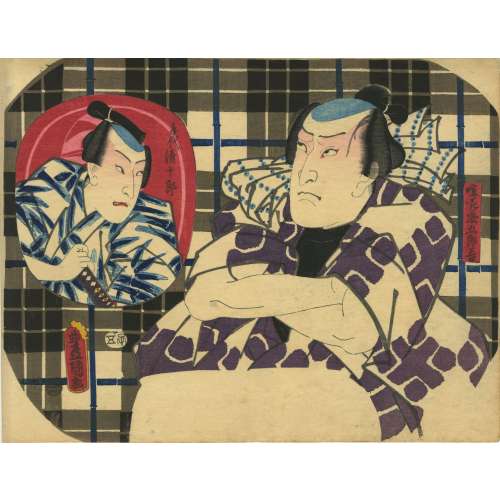 Artist: Utagawa Kunisada [歌川 国貞] a.k.a. Utagawa Toyokuni III [三代歌川豊国] (Japanese, 1786 – 1865). Publisher: Ibaya Senzaburō [伊場屋仙三郎] (Japanese, fl. C. 1845 – 1847). Date seal: [子五] Kaei 5, 5th month (5/1852). Signed: Toyokuni ga [豊国 画] in a red toshidama cartouche. Title: Actor Bandō Takesaburō I as clerk Seijūrō [手代清十郎] (left) and Actor Ichikawa Kodanji IV as Kenkaya Gorōkichi [喧嘩屋五郎吉] (right) in the play Musume ōgi tsui no tatehiki [娘扇一対侠贔屓 (むすめおうぎついのたてひき)] performed at the Nakamura theatre [中村座], in Edo (Tokyo). The playbill for this performance can be found at MFA (Boston) # 11.28042, 11.28285, 11.28286:
Artist: Utagawa Kunisada [歌川 国貞] a.k.a. Utagawa Toyokuni III [三代歌川豊国] (Japanese, 1786 – 1865). Publisher: Ibaya Senzaburō [伊場屋仙三郎] (Japanese, fl. C. 1845 – 1847). Date seal: [子五] Kaei 5, 5th month (5/1852). Signed: Toyokuni ga [豊国 画] in a red toshidama cartouche. Title: Actor Bandō Takesaburō I as clerk Seijūrō [手代清十郎] (left) and Actor Ichikawa Kodanji IV as Kenkaya Gorōkichi [喧嘩屋五郎吉] (right) in the play Musume ōgi tsui no tatehiki [娘扇一対侠贔屓 (むすめおうぎついのたてひき)] performed at the Nakamura theatre [中村座], in Edo (Tokyo). The playbill for this performance can be found at MFA (Boston) # 11.28042, 11.28285, 11.28286: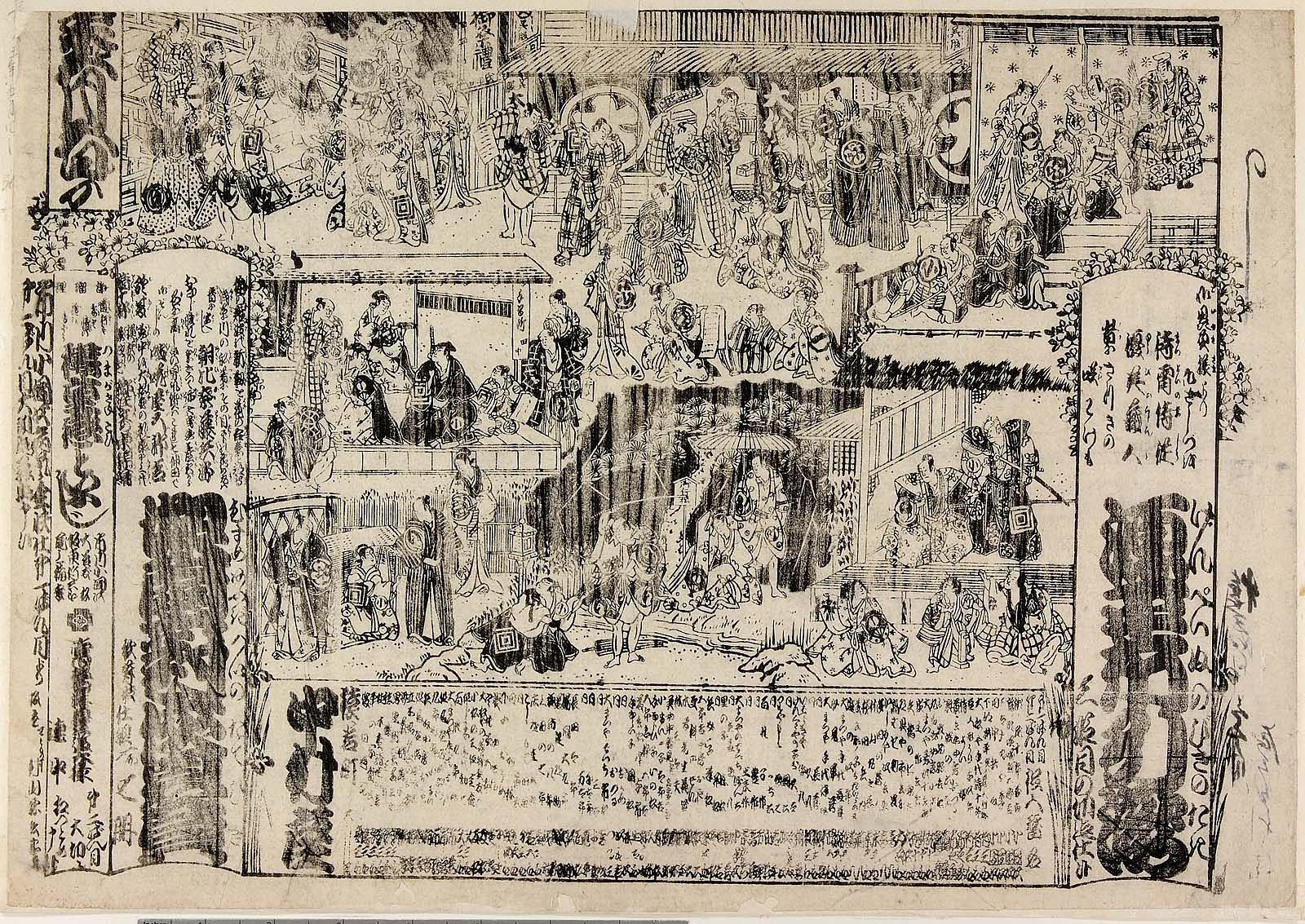 Actors:
Bandō Takesaburō I (初代坂東竹三郎) (Japanese, 1832 – 1877); other names: Shinshi, Shinsui V, Bandō Hikosaburō V [五代目坂東彦三郎], Bandō Tsurunosuke I.
Ichikawa Kodanji IV [市川小團次] (Japanese, 1812 – 1866); other names: Ichikawa Yonejūrō I, Ichikawa Yonezō III, Ichikawa Eizō.
Actors:
Bandō Takesaburō I (初代坂東竹三郎) (Japanese, 1832 – 1877); other names: Shinshi, Shinsui V, Bandō Hikosaburō V [五代目坂東彦三郎], Bandō Tsurunosuke I.
Ichikawa Kodanji IV [市川小團次] (Japanese, 1812 – 1866); other names: Ichikawa Yonejūrō I, Ichikawa Yonezō III, Ichikawa Eizō.
Similar images were then used for the series Seven flourishing plants on lanterns for summer evenings [涼調珍盛の七草] (Suzumi chōchin sakari no nanakusa) published by Ibaya Senzaburō in 1852 (Kaei 5), 6th month.
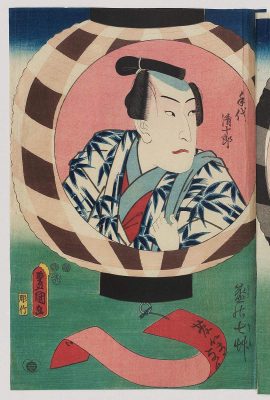
Bandō Takesaburō I (carved by Yokokawa Takejirō): https://collections.mfa.org/objects/219360
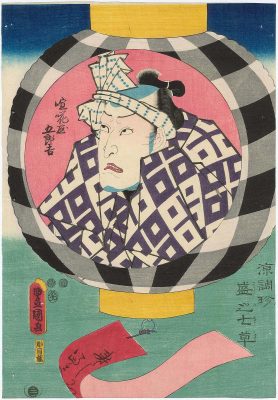
Actor Ichikawa Kodanji IV (carved by Nakamura Tōkichi): https://collections.mfa.org/objects/477146.
-
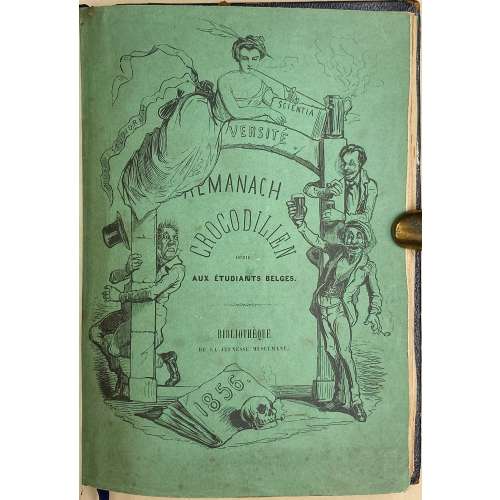 One volume collated 8vo, 19 x 14 cm, bound in black alligator leather. Front wrapper (green) / title-page (white): A female figure smoking a pipe next to a beer mug, reclining over an arch ring lettered “…VERSITÉ” (UNI… not shown), her dress ribbon lettered “MUSA STUDIORUM”, holding a book lettered “SCIENTIA”; within the arch « ALMANACH | CROCODILIEN | DÉDIÉ | AUX ÉTUDIANTS BELGES. | BIBLIOTHÈQUE | DE LA JEUNESSE MUSULMANE. »; below lies a book lettered “1856.”, next to it is a smoking skull; three male figures embracing the arch columns. Half-title: ALMANACH CROCODILIEN | POUR | L’ANNÉE BISSEXTILE, MAIS NÉANMOINS DE GRACE | 1856. || Pagination: [1-5] 6-14 [15-41] 42-134 [137] 138, total 136 pages within the wrappers, original publisher's green wrappers preserved, carte de visite ‘Félicien Rops, Étudiant’ and pink invitation card № 129 for ‘Bal des femmes’ on March 19, 1892 at ‘Fête annuelle du Courier Français’ bound in; in-text woodcuts, initials, head- and tail-pieces after Félicien Rops. Bookplate “Ex Libris Marcellus Schlimovich” with motto “Ars naturam adiuvat” on front pastedown. Stamp of the "Sociedad Hebraica Argentina / Coleccion M. Schlimovich / Varios / No. 2-492” to half-title. Pencil inscription to half-title: "Ex. Félicien Rops" – possibly an own copy of the artist. Collation: π2 1-88 92, total 68 leaves within wrappers. Printer: Typ. de J. Vanbuggenhoudt (Bruxelles). Sociedad Hebraica Argentina; Marcelo Schlimovich (Argentine-Jewish, ca. 1880 – 1960) – provenance. Félicien Rops (Belgian, 1833 – 1898) – artist.
One volume collated 8vo, 19 x 14 cm, bound in black alligator leather. Front wrapper (green) / title-page (white): A female figure smoking a pipe next to a beer mug, reclining over an arch ring lettered “…VERSITÉ” (UNI… not shown), her dress ribbon lettered “MUSA STUDIORUM”, holding a book lettered “SCIENTIA”; within the arch « ALMANACH | CROCODILIEN | DÉDIÉ | AUX ÉTUDIANTS BELGES. | BIBLIOTHÈQUE | DE LA JEUNESSE MUSULMANE. »; below lies a book lettered “1856.”, next to it is a smoking skull; three male figures embracing the arch columns. Half-title: ALMANACH CROCODILIEN | POUR | L’ANNÉE BISSEXTILE, MAIS NÉANMOINS DE GRACE | 1856. || Pagination: [1-5] 6-14 [15-41] 42-134 [137] 138, total 136 pages within the wrappers, original publisher's green wrappers preserved, carte de visite ‘Félicien Rops, Étudiant’ and pink invitation card № 129 for ‘Bal des femmes’ on March 19, 1892 at ‘Fête annuelle du Courier Français’ bound in; in-text woodcuts, initials, head- and tail-pieces after Félicien Rops. Bookplate “Ex Libris Marcellus Schlimovich” with motto “Ars naturam adiuvat” on front pastedown. Stamp of the "Sociedad Hebraica Argentina / Coleccion M. Schlimovich / Varios / No. 2-492” to half-title. Pencil inscription to half-title: "Ex. Félicien Rops" – possibly an own copy of the artist. Collation: π2 1-88 92, total 68 leaves within wrappers. Printer: Typ. de J. Vanbuggenhoudt (Bruxelles). Sociedad Hebraica Argentina; Marcelo Schlimovich (Argentine-Jewish, ca. 1880 – 1960) – provenance. Félicien Rops (Belgian, 1833 – 1898) – artist. -
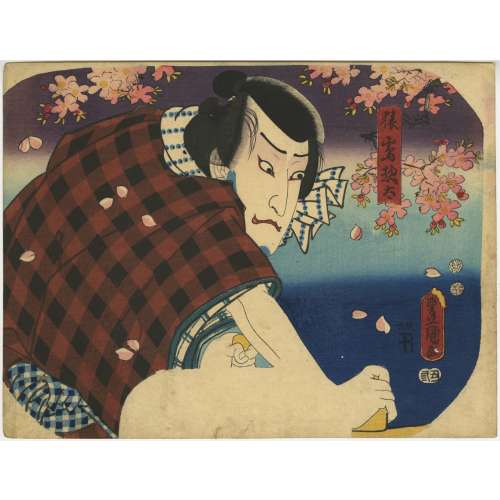 Kabuki actor Arashi Kichisaburō III [嵐吉三郎] as Sarushima Sōta [猿島惣太] in the play Hanamo Yoshida Iwao no Matsuwaka [花吉田岩尾松若] staged at Ichimura-za (市村座), theatre in Edo. Artist: Utagawa Kunisada, a.k.a. Toyokuni III (Japanese, 1786 – 1865) [歌川 国貞]. Publisher: Kojimaya Jūbei (Japanese, 1797-1869), seal: Hanmoto, Jū [板元, 十] (Marks 19-043 | 264c. Date seal and double nanushi censor seals Mera & Watanabe – 3rd month of Kaei 6 (1853). Signed: Toyokuni ga [豊国 画] in a red toshidama cartouche. Media: Fan print (uchiwa-e), 223 x 294 mm. Kabuki actor Arashi Kichisaburō III [嵐吉三郎] (Japanese, 1810 – 1864); other names: Arashi Daizaburō III, Arashi Kitsusaburō III Ref.: Art shop Ezoshi Ukiyoe new collection news, vol. 66, 2023.1 (Jan) # 30, p.8.
Kabuki actor Arashi Kichisaburō III [嵐吉三郎] as Sarushima Sōta [猿島惣太] in the play Hanamo Yoshida Iwao no Matsuwaka [花吉田岩尾松若] staged at Ichimura-za (市村座), theatre in Edo. Artist: Utagawa Kunisada, a.k.a. Toyokuni III (Japanese, 1786 – 1865) [歌川 国貞]. Publisher: Kojimaya Jūbei (Japanese, 1797-1869), seal: Hanmoto, Jū [板元, 十] (Marks 19-043 | 264c. Date seal and double nanushi censor seals Mera & Watanabe – 3rd month of Kaei 6 (1853). Signed: Toyokuni ga [豊国 画] in a red toshidama cartouche. Media: Fan print (uchiwa-e), 223 x 294 mm. Kabuki actor Arashi Kichisaburō III [嵐吉三郎] (Japanese, 1810 – 1864); other names: Arashi Daizaburō III, Arashi Kitsusaburō III Ref.: Art shop Ezoshi Ukiyoe new collection news, vol. 66, 2023.1 (Jan) # 30, p.8. -
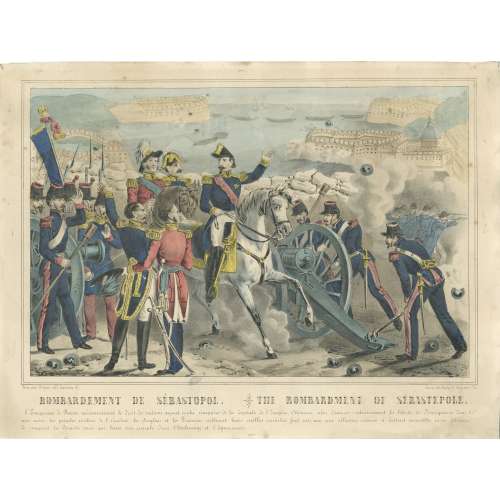 Hand-coloured lithography on wove paper, 250 x 332 mm; black ink stamp “5035” to reverse. Under the frame left: "Paris, chez Riboni, éd. r. Galande, 51"; right: "Paris, lith. Bulla, Pl. Maubert, 26". Below: "BOMBARDEMENT DE SEBASTOPOL. — THE BOMBARDMENT OF SÉBASTOPOLE". Text to bottom. Printers/publishers: Antoine Bulla (fl. 1815 – 1877), François Bulla (fl. c. 1814 – 1855).
Hand-coloured lithography on wove paper, 250 x 332 mm; black ink stamp “5035” to reverse. Under the frame left: "Paris, chez Riboni, éd. r. Galande, 51"; right: "Paris, lith. Bulla, Pl. Maubert, 26". Below: "BOMBARDEMENT DE SEBASTOPOL. — THE BOMBARDMENT OF SÉBASTOPOLE". Text to bottom. Printers/publishers: Antoine Bulla (fl. 1815 – 1877), François Bulla (fl. c. 1814 – 1855). -
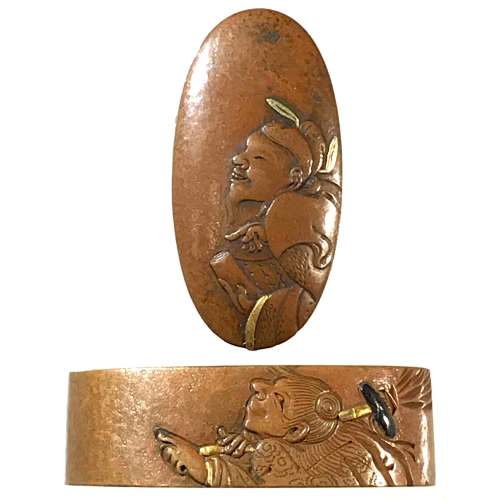 Fuchi-kashira of copper, carved and inlaid with gold and shakudō, with the design of Kanzan (on kashira), Chinese: Hanshan, an eccentric poet of the Tang dynasty with a scroll (618-906) who befriended Jittoku (on fuchi, Chinese: Shide, a kitchen helper at a mountain temple, holding a broom). Fuchi is signed Josui (如⽔). Fuchi (Jittoku, holding a broom): 38 x 22 x 12 mm. Weight: 23g (Nakago hole: 27 x 8.5 mm); Kashira (Kanzan, reading a scroll): 34 x 17 x 9 mm. Weight: 10g. Materials: Copper, gold, shakudō. Techniques: Tsuchi-me-ji (hammer-marked surface); usu-shishiai-bori or usuniku-bori (low-relief carving which leaves the image somewhat higher than the surface - high relief effect); zōgan (inlay). Josui was a daughter of Jochiku Kamo (Markus Sesko, Genealogies).
Fuchi-kashira of copper, carved and inlaid with gold and shakudō, with the design of Kanzan (on kashira), Chinese: Hanshan, an eccentric poet of the Tang dynasty with a scroll (618-906) who befriended Jittoku (on fuchi, Chinese: Shide, a kitchen helper at a mountain temple, holding a broom). Fuchi is signed Josui (如⽔). Fuchi (Jittoku, holding a broom): 38 x 22 x 12 mm. Weight: 23g (Nakago hole: 27 x 8.5 mm); Kashira (Kanzan, reading a scroll): 34 x 17 x 9 mm. Weight: 10g. Materials: Copper, gold, shakudō. Techniques: Tsuchi-me-ji (hammer-marked surface); usu-shishiai-bori or usuniku-bori (low-relief carving which leaves the image somewhat higher than the surface - high relief effect); zōgan (inlay). Josui was a daughter of Jochiku Kamo (Markus Sesko, Genealogies). -
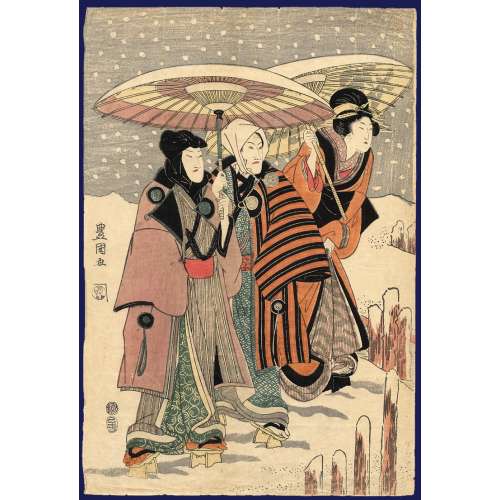 Similar image at MFA under title: Actors and Women in the Snow MFA ACCESSION NUMBER: 11.13568 Date: 1809 (Bunka 6), 12th month Artist: Utagawa Toyokuni I (1769–1825) Publisher Tsuruya Kinsuke (firm name Sôkakudô), № 554 in Marks's "Publishers". DIMENSIONS: Vertical ôban; 38.2 x 25.8 cm (15 1/16 x 10 3/16 in.) MEDIUM OR TECHNIQUE: Woodblock print (nishiki-e); ink and color on paper. Signed: Toyokuni ga (豊国画) Censor's seals: kiwame (改印:極) MFA assumes that this may be "one sheet of incomplete triptych?"
Similar image at MFA under title: Actors and Women in the Snow MFA ACCESSION NUMBER: 11.13568 Date: 1809 (Bunka 6), 12th month Artist: Utagawa Toyokuni I (1769–1825) Publisher Tsuruya Kinsuke (firm name Sôkakudô), № 554 in Marks's "Publishers". DIMENSIONS: Vertical ôban; 38.2 x 25.8 cm (15 1/16 x 10 3/16 in.) MEDIUM OR TECHNIQUE: Woodblock print (nishiki-e); ink and color on paper. Signed: Toyokuni ga (豊国画) Censor's seals: kiwame (改印:極) MFA assumes that this may be "one sheet of incomplete triptych?" -
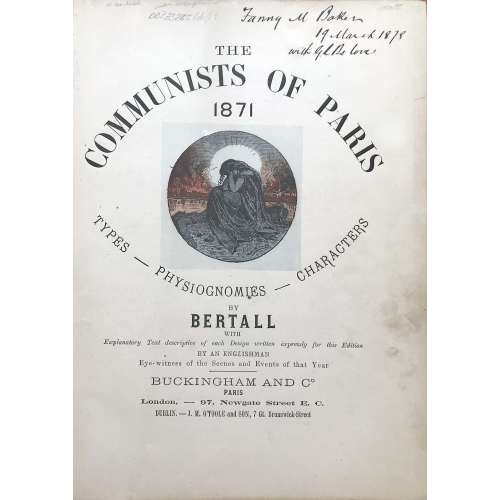 Folio (246 x 321 mm), hardbound in red-brown cloth with gilt lettering and decoration. Content, Introduction by J. E., September, 1873, Artist preface by Bertall, Paris, 1871-1873. Album with 40 hand-colored lithographs by Bertall, numbered 1 through 40, accompanied with extensive descriptions. Ex Libris: Baker. Carpe Diem. Markings: Janny M. Baker with J.L.B. Love, 19 March, 1878 in black ink.
Folio (246 x 321 mm), hardbound in red-brown cloth with gilt lettering and decoration. Content, Introduction by J. E., September, 1873, Artist preface by Bertall, Paris, 1871-1873. Album with 40 hand-colored lithographs by Bertall, numbered 1 through 40, accompanied with extensive descriptions. Ex Libris: Baker. Carpe Diem. Markings: Janny M. Baker with J.L.B. Love, 19 March, 1878 in black ink. -
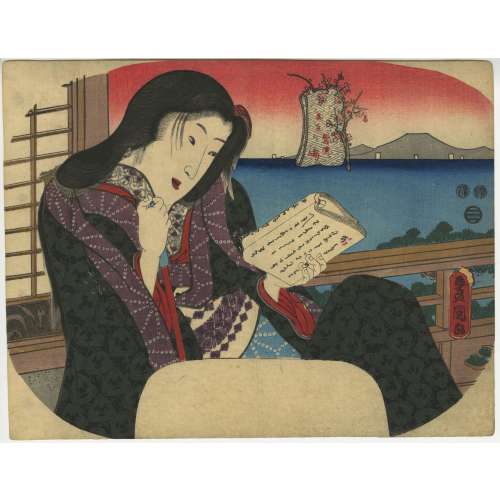 Artist: Utagawa Kunisada [歌川 国貞] a.k.a. Utagawa Toyokuni III [三代歌川豊国] (Japanese, 1786 – 1865). Signed: Toyokuni ga [豊国 画] in a red toshidama cartouche. Publisher: Ibaya Senzaburō [伊場屋仙三郎] (Japanese, c. 1815 – 1869). Double nanushi censor seals: Hama & Magome, Kaei 2-5 (1849 – 1852). An uncut fan print (uchiwa-e, 220 x 292 mm) depicts a beautiful woman sitting on a balcony overlooking a bay and reading a book. Above the book, there is an obi with a pattern of stripes or modified key fret motif, with lettering that reads: 菅原島 [Sugawara-jima] and 美立 [mitate]. The lettering and the blossoming plum branch next to the obi provide an allusion to Sugawara no Michizane [菅原 道真/菅原 道眞] (Japanese, 845 – 903) - a prominent scholar and poet of Heian period exiled from Kyoto to the island of Kyushu as a result of another courtier's slander. A legend says that his beloved plum tree was so fond of its master that it flew to Kyushu with Sugawara. The Davis Museum at Wellesley College describes the print as belonging to the series A Parody of Sugawara Stripe Patterns (Mitate Sugawara-jima). To make the fact of an allusion transparent, Kunisada had changed the usual way of writing "Sugawara stripes" from 菅原縞 to 菅原島 and "mitate" from 見立 to 美立. An unusual spelling was also used to provide additional information to the reader in other cultures. E.g. during the Prohibition Era, the West Coast United States speakeasy bars and bordellos misspelt the items on a menu ("scollops") or in a neon sign ("Martuni's") to tell: here we have more pleasures for you than you may have expected. After Tenpō reforms, the printing of bijin-ga (美人画, "picture of beautiful woman") images was restricted. Our print disguises a typical bijin-ga as an advertisement of an obi (帯, a kimono sash) fabric pattern. "The market of portraits was satisfied and the authorities fooled" [Rebecca Salter. Japanese popular prints. — Honolulu: University of Hawaii Press, 2006].
Artist: Utagawa Kunisada [歌川 国貞] a.k.a. Utagawa Toyokuni III [三代歌川豊国] (Japanese, 1786 – 1865). Signed: Toyokuni ga [豊国 画] in a red toshidama cartouche. Publisher: Ibaya Senzaburō [伊場屋仙三郎] (Japanese, c. 1815 – 1869). Double nanushi censor seals: Hama & Magome, Kaei 2-5 (1849 – 1852). An uncut fan print (uchiwa-e, 220 x 292 mm) depicts a beautiful woman sitting on a balcony overlooking a bay and reading a book. Above the book, there is an obi with a pattern of stripes or modified key fret motif, with lettering that reads: 菅原島 [Sugawara-jima] and 美立 [mitate]. The lettering and the blossoming plum branch next to the obi provide an allusion to Sugawara no Michizane [菅原 道真/菅原 道眞] (Japanese, 845 – 903) - a prominent scholar and poet of Heian period exiled from Kyoto to the island of Kyushu as a result of another courtier's slander. A legend says that his beloved plum tree was so fond of its master that it flew to Kyushu with Sugawara. The Davis Museum at Wellesley College describes the print as belonging to the series A Parody of Sugawara Stripe Patterns (Mitate Sugawara-jima). To make the fact of an allusion transparent, Kunisada had changed the usual way of writing "Sugawara stripes" from 菅原縞 to 菅原島 and "mitate" from 見立 to 美立. An unusual spelling was also used to provide additional information to the reader in other cultures. E.g. during the Prohibition Era, the West Coast United States speakeasy bars and bordellos misspelt the items on a menu ("scollops") or in a neon sign ("Martuni's") to tell: here we have more pleasures for you than you may have expected. After Tenpō reforms, the printing of bijin-ga (美人画, "picture of beautiful woman") images was restricted. Our print disguises a typical bijin-ga as an advertisement of an obi (帯, a kimono sash) fabric pattern. "The market of portraits was satisfied and the authorities fooled" [Rebecca Salter. Japanese popular prints. — Honolulu: University of Hawaii Press, 2006]. -
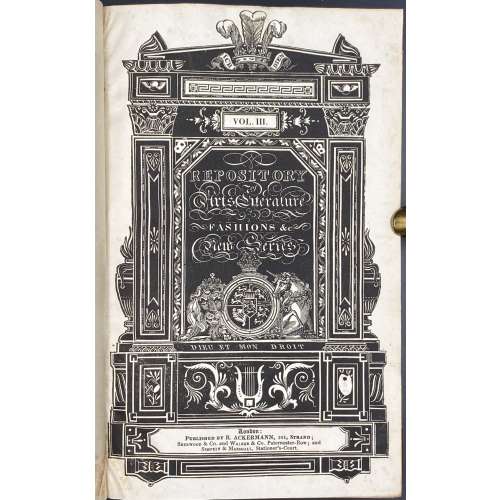 Pagination: [2] – letterpress title / blank, t.p. contents / to readers, [1] 2-368 [4 index], + 6 b/w (one folding) and 28 coloured plates (total 34). Collation: 4to; letterpress title, [A]1 B-Z4 Aa-Zz4 3A-3B4 3C3. Binding: 25 x 16 cm; gilt-ruled half-calf over marbled boards, flat spine, gilt-ruled compartments, gilt lettering. 5 aquatints by Thomas Rowlandson (British, 1757 – 1827): Table D'Hote; Consulting the Prophet; The Prophet discovering himself and exposing the deception; The Arrival in Paris; Liberality to infirm beggars on leaving Yrvi. References: Martin Hardie (1906), p.310 [LIB-2623.2021]; R. V. Tooley (1935), p. 26 [LIB-2641.2021]; J. R. Abbey (1953), Cat. № 212, p. 167 [LIB-2622.2021].
Pagination: [2] – letterpress title / blank, t.p. contents / to readers, [1] 2-368 [4 index], + 6 b/w (one folding) and 28 coloured plates (total 34). Collation: 4to; letterpress title, [A]1 B-Z4 Aa-Zz4 3A-3B4 3C3. Binding: 25 x 16 cm; gilt-ruled half-calf over marbled boards, flat spine, gilt-ruled compartments, gilt lettering. 5 aquatints by Thomas Rowlandson (British, 1757 – 1827): Table D'Hote; Consulting the Prophet; The Prophet discovering himself and exposing the deception; The Arrival in Paris; Liberality to infirm beggars on leaving Yrvi. References: Martin Hardie (1906), p.310 [LIB-2623.2021]; R. V. Tooley (1935), p. 26 [LIB-2641.2021]; J. R. Abbey (1953), Cat. № 212, p. 167 [LIB-2622.2021]. -
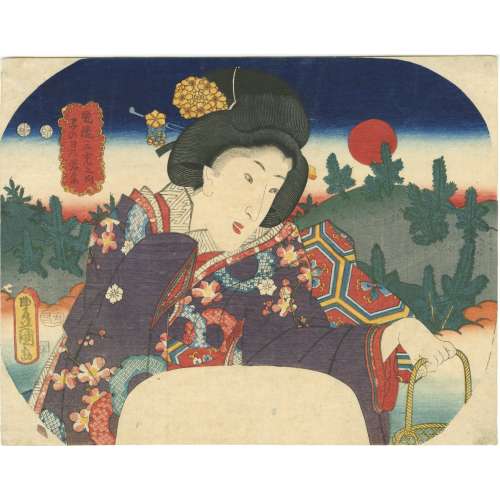 An uncut fan print shows a young woman holding a basket on a landscape background with hills and pines under a rising sun. Haruo Shirane: "Under the luni-solar calendar, the New Year coincided with the beginning of spring, making it the most important observance of the year for the aristocracy. In the Heian period, New Year ceremonies extended from New Year’s Day (Ganjitsu) to the Day of the Rat (Nenohi), which usually fell on the seventh day of the First Month, when courtiers went out to the fields (no), pulled up small pines, and gathered new herbs (wakana) as a prayer for long life. This ritual gradually spread to the provinces and to commoners, eventually resulting in the New Year practice of the gate pine (kadomatsu), in which a pair of small pines was placed at the gate of a house. A popular Heian-period painting topic representing the First Month was “prayers on the Day of the Rat” (Nenohi no asobi), which depicted the auspicious scene of pulling up small pines in a spring field. Both young herbs and gathering young herbs, particularly at Kasuga Field, became major poetic topics for the First Month, appearing in both the spring and celebration (ga) books of the Kokinshū (Collection of Japanese Poems Old and New, ca. 905). By the Kamakura period, the observance of the Day of the Rat had been abandoned at the imperial court, but the custom of gathering and eating young greens continued as the annual ceremony known as the Seven Grasses (Nanakusa). Note: The Heian-period ritual of pulling up the roots of small pines (komatsu ) on the first Day of the Rat derives from the homonyms ne (rat) and ne (root). Pulling up roots was auspicious, since it implied lengthening the year. The rising sun (hinode) was considered an auspicious sight, particularly at the beginning of the year". [Haruo Shirane, Japan and the Culture of the Four Seasons. Nature, Literature, and the Arts. — Columbia University, NY, 2012]. Title: Gathering of the young herbs on the Day of the Rat [子の日乃若菜] (Nenohi no wakana). Series: Three elegant sources of light [風流三光の内] (fūryū sankō no uchi); meaning the sun, the moon and the stars). Artist: Utagawa Kunisada [歌川 国貞]; a.k.a. Utagawa Toyokuni III [三代歌川豊国] (Japanese, 1786 – 1865). Signed: Toyokuni ga [豊国 画] in a yellow toshidama cartouche. Publisher’s seal: Izuzen (Marks: seal 06-029 | U103b) Date and double nanushi censor seals: Mera and Watanabe, Kaei 6 (1853). A similar theme can be found in Kunisadai's triptych published in about 1844 (HARA SHOBO):
An uncut fan print shows a young woman holding a basket on a landscape background with hills and pines under a rising sun. Haruo Shirane: "Under the luni-solar calendar, the New Year coincided with the beginning of spring, making it the most important observance of the year for the aristocracy. In the Heian period, New Year ceremonies extended from New Year’s Day (Ganjitsu) to the Day of the Rat (Nenohi), which usually fell on the seventh day of the First Month, when courtiers went out to the fields (no), pulled up small pines, and gathered new herbs (wakana) as a prayer for long life. This ritual gradually spread to the provinces and to commoners, eventually resulting in the New Year practice of the gate pine (kadomatsu), in which a pair of small pines was placed at the gate of a house. A popular Heian-period painting topic representing the First Month was “prayers on the Day of the Rat” (Nenohi no asobi), which depicted the auspicious scene of pulling up small pines in a spring field. Both young herbs and gathering young herbs, particularly at Kasuga Field, became major poetic topics for the First Month, appearing in both the spring and celebration (ga) books of the Kokinshū (Collection of Japanese Poems Old and New, ca. 905). By the Kamakura period, the observance of the Day of the Rat had been abandoned at the imperial court, but the custom of gathering and eating young greens continued as the annual ceremony known as the Seven Grasses (Nanakusa). Note: The Heian-period ritual of pulling up the roots of small pines (komatsu ) on the first Day of the Rat derives from the homonyms ne (rat) and ne (root). Pulling up roots was auspicious, since it implied lengthening the year. The rising sun (hinode) was considered an auspicious sight, particularly at the beginning of the year". [Haruo Shirane, Japan and the Culture of the Four Seasons. Nature, Literature, and the Arts. — Columbia University, NY, 2012]. Title: Gathering of the young herbs on the Day of the Rat [子の日乃若菜] (Nenohi no wakana). Series: Three elegant sources of light [風流三光の内] (fūryū sankō no uchi); meaning the sun, the moon and the stars). Artist: Utagawa Kunisada [歌川 国貞]; a.k.a. Utagawa Toyokuni III [三代歌川豊国] (Japanese, 1786 – 1865). Signed: Toyokuni ga [豊国 画] in a yellow toshidama cartouche. Publisher’s seal: Izuzen (Marks: seal 06-029 | U103b) Date and double nanushi censor seals: Mera and Watanabe, Kaei 6 (1853). A similar theme can be found in Kunisadai's triptych published in about 1844 (HARA SHOBO):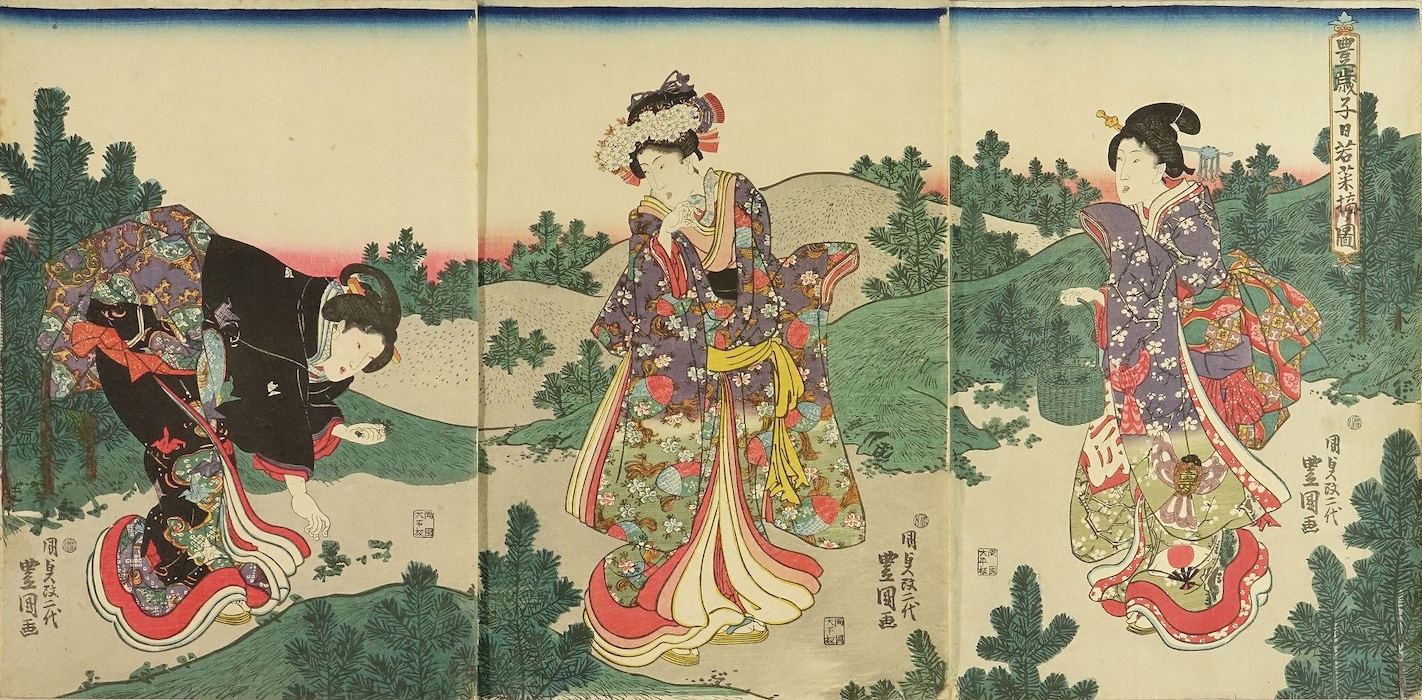
豊国三代「豊歳子日若菜摘ノ図」


